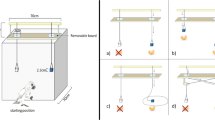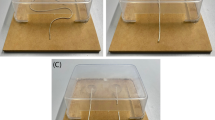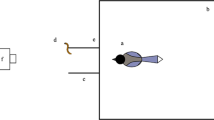The ability of the Corvidae to understand the logical structure of a task consisting of pulling a string attached to a bait was studied in a series of experiments with different relative positions of multiple strings. Some hooded crows (Corvus cornix L.) and common raven (Corvus corax L.) could successfully solve tasks in which the strings did not cross each other but were arranged in such a way that the bait was opposite the end of an “empty” string. Hooded crows also solved a task in which the bait was attached to each of two strings, but one string was broken, preventing it from pulling the bait. A task in which two crossing strings, in which the bait was again opposite the end of the empty string was not solved by hooded crows. These data lead to the conclusion that some members of both species are able to pick out the logical structure of tasks of this type.
Similar content being viewed by others
References
M. S. Bagotskaya. A. A. Smirnova, and Z. A. Zorina, “Comparative studies of the abilities of corvids to solve tasks involving procurement of suspended baits,” Zh. Vyssh. Nerv. Deyat., 60, No. 2, 208–216 (2010).
V. Keler, Studies of Intellect in Humanoid Monkeys [in Russian], Komakademiya, Moscow (1930).
V. M. Konstantinov, V. A. Ponomarev, L. N. Voronov, Z. A. Zorina, D. A. Krasnobaev, I. G. Lebedev, V. A. Margolin, I. I. Rakhimov, A. G. Rezanov, and A. S. Rodimstev, The Hooded Crow (Corvus cornix) in the Manmade Landscapes of the Paleoartic (questions of synanthropization and urbanization) [in Russian], Moscow State Pedagogical University, Moscow (2007).
N. N. Ladygina-Kots, Constructive and Tool-Using Activity in Higher Monkeys [in Russian], USSR Academy of Sciences Press, Moscow (1959).
S. L. Novoselova, Development of the Intellectual Bases of Activity in Primates [in Russian], NPO MODEK, Voronezh (2001).
G. Z. Roginskii, Skills and Rudiments of Intellectual Activity in Anthropoids (Chimpanzees), Nauka, Leningrad (1948).
G. Z. Rozinskii, Development of the Brain and Mental Activity [in Russian], Lenizdat, Leningrad (1948).
K. E. Fabri, Tool-Using Activity of Animals [in Russian], Znanie, Moscow (1980).
D. K. Adams, “Experiments studies of adaptive behavior in cats,” Comp. Psychol. Monogr., 6, No. 1, 1–128 (1929).
A. M. Auersperg, G. K. Gajdon, and J. Huber, “Kea (Nestor notabilis) consider special relationships between objects in the support problem,” Biol. Lett., 5, No. 4, 455–458 (2009).
J. Balasch, P. Sabater, and T. Padrosa, “Perceptual learning ability in Mandrillus sphinx and Cercopithecus nictitans,” Rev. Espanol. Fisiol., 30, 15–20 (1974).
L. A. Bluff, A. A. S. Weir, C. Rutz, J. H. Wimpenny, and A. Kacelnik, “Tool-related cognition in new Caledonian crows,” Comp. Cogn. Behav. Rev., 2, 1–25 (2007).
J. Cha and J. E. King, “The learning of patterned strings problems by squirrel monkeys,” Anim. Behav., 17, 65–67 (1969).
G. Ducker and B. Rensch, “Solution of patterned string problems by birds,” Behaviour, 62, No. 1–2, 164–173 (1977).
G. Finch, “The solution of patterned string problems by chimpanzees,” J. Comp. Physiol., 32, 83–90 (1941).
G. J. Fischer and S. L. Kitchener, “Comparative learning in young gorillas and orang-utans,” J. Gen. Psychol., 107, 337–348 (1965).
L. G. Halsey, B. M. Bezerra, and A. S. Souto, “Can wild common marmosets (Callithrix jacchus) solve the parallel strings task?” Anim. Cogn., 9, 229–233 (2006).
H. F. Harlow and P. H. Settlage, “Comparative behavior of primates. VII. Capacity of monkeys to solve patterned string tests,” J. Comp. Psychol., 18, 423–435 (1935).
M D. Hauser, J. Kralik, and C. Botto-Mahan, “Problem solving and functional design features: experiments on cotton-top tamarins, Sanguinus oedipus oedipus,” Anim. Behav., 57, 5656–582 (1999).
B. Heinrich, “An experimental investigation of insight in common ravens (Corvus corax),” The Auk, 112, 994–1003 (1995).
B. Osthaus, S. Lea, and A. Slater, “Dogs (Canis lupus familiaris) fail to show understanding of means-end connections in a string-pulling task,” Anim. Cogn., 8, 37–47 (2005).
C. Schuck-Paim, A. Borsari, and E. B. Ottoni, “Means to an end: Neotropical parrots manage to pull strings to meet their goals,” Anim. Cogn., 12, 287–301 (2009).
A. H. Taylor, G. R. Hunt, F. S. Medina, and R. D. Gary, “Do New Caledonian crows solve physical problems through causal reasoning?” Proc. Biol. Sci., 276, 247–254 (2009).
M. Tomasello and J. Call, Primate Cognition, Oxford University Press, New York (1997).
D. Werdenich and L. Huber, “A case of quick problem solving in birds: string pulling in keas, Nestor notabilis,” Anim. Behav., 71, 855–863 (2006).
E. Whitt, M. Douglas, B. Osthaus, and I. Hocking, “Domestic cats (Felis catus) do not show causal understanding in a string-pulling task,” Anim. Cogn., 12, No. 5, 739–743 (2009).
Author information
Authors and Affiliations
Corresponding author
Additional information
Translated from Zhurnal Vysshei Nervnoi Deyatel’nosti imeni I. P. Pavlova, Vol. 60, No. 5, pp. 543–551, September–October, 2010.
Rights and permissions
About this article
Cite this article
Bagotskaya, M.S., Smirnova, A.A. & Zorina, Z.A. Corvidae Can Understand Logical Structure in Baited String-Pulling Tasks. Neurosci Behav Physi 42, 36–42 (2012). https://doi.org/10.1007/s11055-011-9529-z
Received:
Accepted:
Published:
Issue Date:
DOI: https://doi.org/10.1007/s11055-011-9529-z




